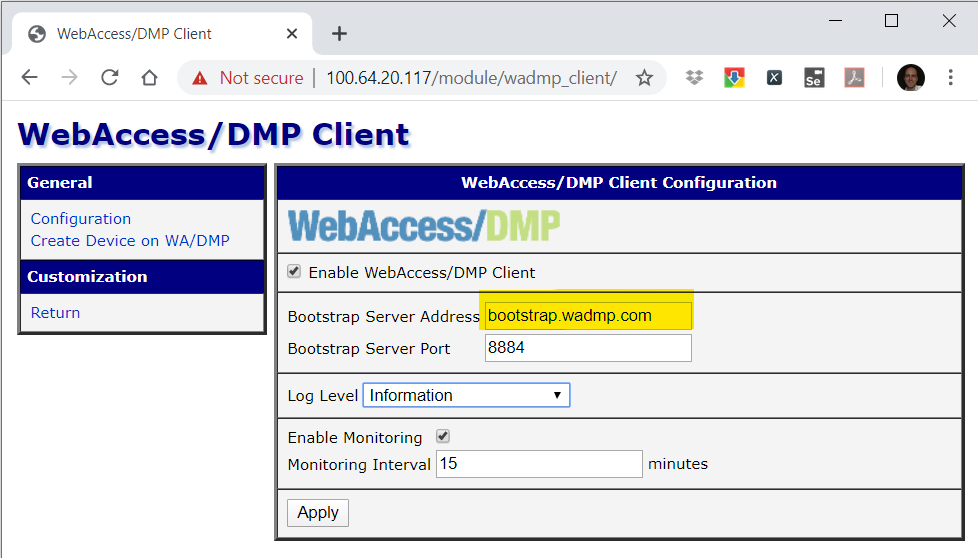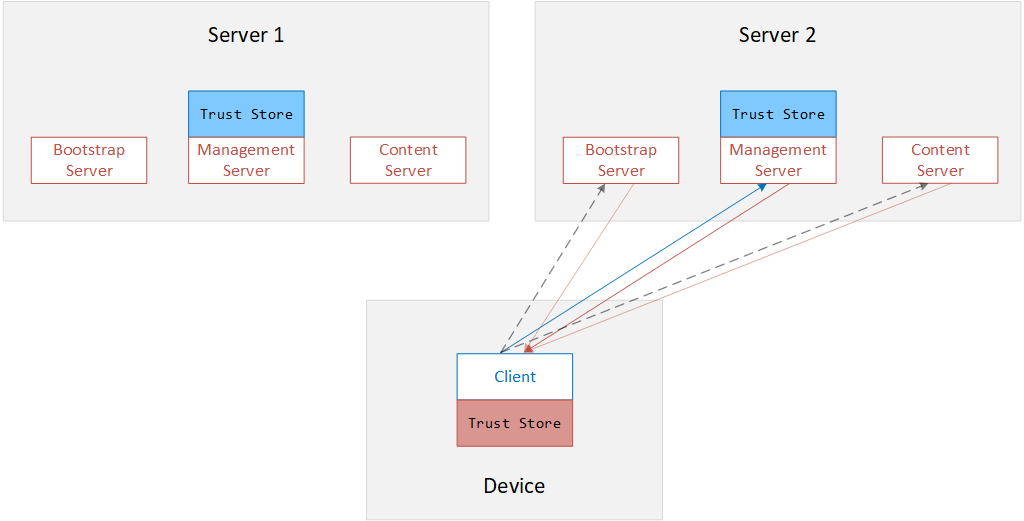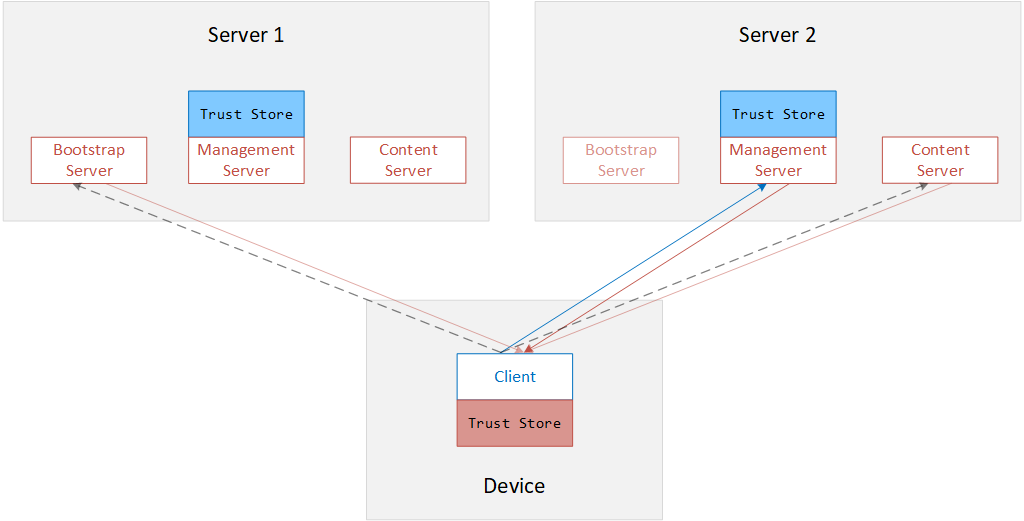# How to Move a Device from One WebAccess/DMP Management Server to Another
# Introduction
# Background
WebAccess/DMP follows the LightWeightM2M (opens new window) protocol for "Client-Initiated Bootstrap", using "Certificate mode with Enrollment over Secure Transport" for maximum security.
You do not need to understand this procedure to follow it, but it may provide helpful background information.
What you do need to understand is that a WebAccess/DMP server installation comprises several individual "servers":

The Bootstrap Server is used to direct the client to one or more Management Servers.
During a bootstrap procedure, the Bootstrap Server provides two things to the client:
- The address of the Management Server which will manage the device;
- A security certificate that the client can use to identify itself to that Management Server.
The Management Server performs all of the actual device management tasks: firmware upgrade, device configuration, device monitoring, etc.
The Management Server may occasionally direct the client to download a file from the Content Server, but the Content Server is irrelevant for this discussion.
# Client Configuration
When a client on a device is starting for the first time, the only information it has is the address of a Bootstrap Server.
The following image is a screenshot of the "WebAccess/DMP Client" Router Apps running on the local webserver of a router:
 Note that there is no way to directly configure the client to point to a new Management Server.
Note that there is no way to directly configure the client to point to a new Management Server.
To move a device to a new Management Server, you have two choices.
# Option 1
Assuming you have access to the local web server on the device, you can change the Bootstrap Server Address in the Router App configuration screen.

However, there are disadvantages to this approach:
- The configuration change can only be done manually;
- The device will forget everything about the original Bootstrap Server. If the initial connection to the new Bootstrap Server (on Server 2) fails, the device is lost;
- If the initial connection to the new Bootstrap Server (on Server 2) succeeds, but later Server 2 fails for some reason, it may not be possible to recover the device.
# Option 2
Maintain the connection between the device and the original Bootstrap Server, but re-configure the Bootstrap Server to direct the device to the new Management Server.

Advantages:
- The configuration change can be done via WebAccess/DMP itself and can therefore be automated for multiple devices;
- If Server 2 fails for some reason, the device will always fall back to the original Bootstrap Server for new instructions;
- This approach allows for new use-cases and business models. For example, you can temporarily move a device to a new Management Server, safe in knowing that when the new server dies, the device can be recovered.
The rest of this article will explain the procedure for this approach (Option 2).
Note: This procedure has been automated in a Jupyter Notebook that is available in our public GitHub repo: github.com/wadmp/wadmp.github.io/blob/master/jupyter_notebooks/move_device.ipynb (opens new window)
# General Case
In the block diagrams above, we assume that the client on the device was initially configured to connect to the Bootstrap Server on Server 1.
Usually, the requirement is to move the device to a second server (Server 2) and possibly move it back again (to Server 1) later.
But we also need to consider the most general case. Imagine the device has already been moved from Server 1 to Server 2. Can we move it from Server 2 to Server 3? And from there to Server 4?
The answer is yes. The key is that the device always remembers the URL of its original Bootstrap Server.
In the Jupyter Notebook (opens new window), you will see that the code handles the general case automatically. It refers to the original Bootstrap Server as "Server 0".
Usually, Server 0 is Server 1. So to avoid over-complicating things, we will make that assumption for the remainder of this document.
# Procedure
All of the following steps can be performed using the public REST API of both servers.
You can follow along manually by using the "OpenAPI" (Swagger) documentation page, for example, api.wadmp.com (opens new window). You should have an equivalent page for the second server instance.
Alternatively, the whole procedure has been automated in a Jupyter Notebook that is available in our public GitHub repo: github.com/wadmp/wadmp.github.io/blob/master/jupyter_notebooks/move_device.ipynb (opens new window)
# Step 1: Tell the Bootstrap Server to which Management Server the Device Should Be Directed
By default, in any particular WebAccess/DMP server deployment, the Bootstrap Server is configured to direct all devices to the Management Server co-located with the Bootstrap Server.
In this step, you configure the Bootstrap Server on Server 1 to direct a device to a different Management Server: the Management Server on Server 2.
# Step 1a
Using the Public API of Server 1 ...
In the Bootstrap section, send a POST request to "/bootstrap" to create a new Management Server definition:

- "name" is not essential: it only serves as a label or reminder for the user.
- "address" is the IP address or DNS name of the Management Server.
- "port" is the TCP port number of the Management Server. (Usually, 8883, which is the standard port number for MQTT over TLS.) Finally, * "company_id" is your company ID in the system. (Can be obtained using the GET /companies endpoint if you don't know it already.)
# Step 1b
Using the Public API of Server 1 ...
In the Devices section, send a PUT request to "/management/devices/{macAddress}/bootstrap-server/{serverId}", using the serverId obtained previously.

This means that the next time the devices perform a Bootstrap procedure, they will be directed to the new Management Server.
But we are not ready to re-direct it yet.
# Step 2: Tell the New Management Server to Trust the Device's Bootstrap Server
The Management Server uses TLS with mutual authentication. i.e., The client must present a digital certificate. Furthermore, the Management Server must trust the issuer of this certificate.
By default, the Bootstrap Server co-located with a Management Server is automatically trusted by that Management Server.
However, if your device has been directed to a new Management Server, then by default, that Management Server will not allow the device to connect because the client certificate presented was issued by an unknown Bootstrap Server.
You must update the "trust store" of the new Management Server with the certificates used by the device's Bootstrap Server.
# Step 2a
Using the Public API of Server 1 ...
In the Bootstrap section, use the "GET /certs" endpoint to check what certificates are in the trust store of the current Management Server. i.e., The Management Server on Server 1, where the device is currently connected.

Permissions
To use the "GET /certs" endpoint, you must have the "Device Management Server" permission on Server 1.
In the WebAccess/DMP UI, you can view and modify the permissions of any user (on a per-company basis):
Alternatively, using the Public API, you can view permissions using the "GET /users/{id}" endpoint and modify them using the "PUT /users/{id}/companies" endpoint.
The "GET /certs" request will return a JSON object like this:
{
"data": {
"certs": "LS0tLS1CRUdJTiBDRVJUSUZJQ0FURS0tLS0t...VElGSUNBVEUtLS0tLQo="
},
"success": true
}
"certs" is a Base64-encoded string. You can decode it using a web service like www.base64decode.org/ (opens new window)
When decoded, you will see that it is a PEM file containing several X.509 certificates, usually three:
-----BEGIN CERTIFICATE-----
MIICzTCCAnOgAwIBAgIUHAGWV7GFmEummqHfcDEEr4HyM2MwCgYIKoZIzj0EAwIw
gbMxCzAJBgNVBAYTAklFMQ8wDQYDVQQIDAZHYWx3YXkxETAPBgNVBAcMCE9yYW5t
...
DyWJ466GETl5oF8b036sAiBty23FHKQLWSa7v6Cl13LNPOP66FRDt0jneNZHF7QE
wA==
-----END CERTIFICATE-----
-----BEGIN CERTIFICATE-----
MIICyDCCAm2gAwIBAgICEAEwCgYIKoZIzj0EAwIwgboxCzAJBgNVBAYTAklFMQ8w
DQYDVQQIDAZHYWx3YXkxIDAeBgNVBAoMF0FkdmFudGVjaCBCK0IgU21hcnRXb3J4
...
BAMCAYYwCgYIKoZIzj0EAwIDSQAwRgIhAMZNGdhH1KOm33dA8yibKUQK8uDtKoJJ
1zphLoEB3iOhAiEA9HOyt8t83eEGrdsL2Zdd9PaBaoK21MqU7vjA96L6xIM=
-----END CERTIFICATE-----
-----BEGIN CERTIFICATE-----
MIICxjCCAmugAwIBAgICEAAwCgYIKoZIzj0EAwIwgbMxCzAJBgNVBAYTAklFMQ8w
DQYDVQQIDAZHYWx3YXkxETAPBgNVBAcMCE9yYW5tb3JlMSAwHgYDVQQKDBdBZHZh
...
AgGGMAoGCCqGSM49BAMCA0kAMEYCIQDVUuB//bFW1T900osnQgElyQq8Qe3uPG0h
z6CnvTPHCAIhAKcu4nnZydZg1PTYwOZjZ54P5t+eIJKr3cL1Ts3J9Shb
-----END CERTIFICATE-----
Optional step
If you are interested, you can split the file into individual certs and then use OpenSSL command-line tools to examine them:
$ openssl x509 -in <cert> -text -nooutYou will see that the certificates are chained and end in a self-signed root CA cert. This is the trust anchor for device authentication.
Background info.
If you are really interested 😃, you should know that there is another way to check the Management Server's trust store without using the API.
During the TLS (v1.2) handshake, the server sends a "Certificate Request" message to the client. This message includes the client Certificate Authorities listed in the server’s trust store.
If you use the
openssl s_clientcommand to connect to the Management Server, the output will include "Acceptable client certificate CA names", already decoded for you:
$ openssl s_client -connect management.wadmp.com:8883 -CAfile /opt/projects/pki/server/SCA0/certs/ca.cert.pem -tls1_2
CONNECTED(00000005)
depth=3 C = IE, ST = Galway, L = Oranmore, O = "Advantech B+B SmartWorx", OU = IoT, CN = Falcon Server Root CA (SCA0), emailAddress = bbcmsmanager@advantech.com
verify return:1
depth=2 C = IE, ST = Galway, O = "Advantech B+B SmartWorx", OU = IoT, CN = Falcon Server Intermediate Level-1 CA (SCA1_production), emailAddress = webaccessdmp@advantech.com
verify return:1
depth=1 C = IE, ST = Galway, O = "Advantech B+B SmartWorx", OU = IoT, CN = Falcon Server CA for Production (SCA2_production), emailAddress = webaccessdmp@advantech.com
verify return:1
depth=0 C = IE, ST = Galway, L = Oranmore, O = "Advantech B+B SmartWorx", OU = IoT, CN = "WADMP Management Server, Production Cloud", emailAddress = webaccessdmp@advantech.com
verify return:1
140025034838464:error:14094410:SSL routines:ssl3_read_bytes:sslv3 alert handshake failure:../ssl/record/rec_layer_s3.c:1528:SSL alert number 40
---
Certificate chain
0 s:C = IE, ST = Galway, L = Oranmore, O = "Advantech B+B SmartWorx", OU = IoT, CN = "WADMP Management Server, Production Cloud", emailAddress = webaccessdmp@advantech.com
i:C = IE, ST = Galway, O = "Advantech B+B SmartWorx", OU = IoT, CN = Falcon Server CA for Production (SCA2_production), emailAddress = webaccessdmp@advantech.com
1 s:C = IE, ST = Galway, O = "Advantech B+B SmartWorx", OU = IoT, CN = Falcon Server CA for Production (SCA2_production), emailAddress = webaccessdmp@advantech.com
i:C = IE, ST = Galway, O = "Advantech B+B SmartWorx", OU = IoT, CN = Falcon Server Intermediate Level-1 CA (SCA1_production), emailAddress = webaccessdmp@advantech.com
2 s:C = IE, ST = Galway, O = "Advantech B+B SmartWorx", OU = IoT, CN = Falcon Server Intermediate Level-1 CA (SCA1_production), emailAddress = webaccessdmp@advantech.com
i:C = IE, ST = Galway, L = Oranmore, O = "Advantech B+B SmartWorx", OU = IoT, CN = Falcon Server Root CA (SCA0), emailAddress = bbcmsmanager@advantech.com
---
Server certificate
-----BEGIN CERTIFICATE-----
MIIDSTCCAvCgAwIBAgICEAEwCgYIKoZIzj0EAwIwgbUxCzAJBgNVBAYTAklFMQ8w
DQYDVQQIDAZHYWx3YXkxIDAeBgNVBAoMF0FkdmFudGVjaCBCK0IgU21hcnRXb3J4
MQwwCgYDVQQLDANJb1QxOjA4BgNVBAMMMUZhbGNvbiBTZXJ2ZXIgQ0EgZm9yIFBy
b2R1Y3Rpb24gKFNDQTJfcHJvZHVjdGlvbikxKTAnBgkqhkiG9w0BCQEWGndlYmFj
Y2Vzc2RtcEBhZHZhbnRlY2guY29tMB4XDTE5MTAwMzEzMjc1NloXDTIwMTAwMjEz
Mjc1NlowgcAxCzAJBgNVBAYTAklFMQ8wDQYDVQQIDAZHYWx3YXkxETAPBgNVBAcM
CE9yYW5tb3JlMSAwHgYDVQQKDBdBZHZhbnRlY2ggQitCIFNtYXJ0V29yeDEMMAoG
A1UECwwDSW9UMTIwMAYDVQQDDClXQURNUCBNYW5hZ2VtZW50IFNlcnZlciwgUHJv
ZHVjdGlvbiBDbG91ZDEpMCcGCSqGSIb3DQEJARYad2ViYWNjZXNzZG1wQGFkdmFu
dGVjaC5jb20wWTATBgcqhkjOPQIBBggqhkjOPQMBBwNCAASFexFsIrjfKwEufq1M
qgHlosaPLhAerIAtEb4lnwBMr22b+7WhnCIqlDCyTteRuXGZYuftNEaGQL/xQkKr
7/tRo4HiMIHfMAkGA1UdEwQCMAAwEQYJYIZIAYb4QgEBBAQDAgZAMDMGCWCGSAGG
+EIBDQQmFiRPcGVuU1NMIEdlbmVyYXRlZCBTZXJ2ZXIgQ2VydGlmaWNhdGUwHQYD
VR0OBBYEFGPi8TycsTD6SUrV3BwDkb5/XugjMB8GA1UdIwQYMBaAFCucwq3rviWz
QYQ2/+o0S3xrtqRZMA4GA1UdDwEB/wQEAwIFoDATBgNVHSUEDDAKBggrBgEFBQcD
ATAlBgNVHREEHjAcghRtYW5hZ2VtZW50LndhZG1wLmNvbYcEDU/2KTAKBggqhkjO
PQQDAgNHADBEAiA0M6lBmeiXfW9wmD/UOptPd+jeRAd+H4xutW3ZUBOwjAIgBKeD
ZD/bDFx1a1mT3+F977T5LQNWMUxxLLtJsQDtWDo=
-----END CERTIFICATE-----
subject=C = IE, ST = Galway, L = Oranmore, O = "Advantech B+B SmartWorx", OU = IoT, CN = "WADMP Management Server, Production Cloud", emailAddress = webaccessdmp@advantech.com
issuer=C = IE, ST = Galway, O = "Advantech B+B SmartWorx", OU = IoT, CN = Falcon Server CA for Production (SCA2_production), emailAddress = webaccessdmp@advantech.com
---
Acceptable client certificate CA names
C = IE, ST = Galway, O = "Advantech B+B SmartWorx", OU = IoT, CN = Falcon Device CA for Production (DCA2_production), emailAddress = webaccessdmp@advantech.com
C = IE, ST = Galway, O = "Advantech B+B SmartWorx", OU = IoT, CN = Falcon Device Intermediate Level-1 CA (DCA1_production), emailAddress = webaccessdmp@advantech.com
C = IE, ST = Galway, L = Oranmore, O = "Advantech B+B SmartWorx", OU = IoT, CN = Falcon Device Root CA (DCA0), emailAddress = bbcmsmanager@advantech.com
C = IE, ST = Galway, O = "Advantech B+B SmartWorx", OU = IoT, CN = Falcon Device CA for Development Environment (DCA2_develop), emailAddress = bbcmsmanager@advantech.com
C = IE, ST = Galway, O = "Advantech B+B SmartWorx", OU = IoT, CN = Falcon Test Device Intermediate Level-1 CA (DCA1_test), emailAddress = bbcmsmanager@advantech.com
C = IE, ST = Galway, L = Oranmore, O = "Advantech B+B SmartWorx", OU = IoT, CN = Falcon User CA (UCA_Advantech1), emailAddress = ben.kinsella@advantech.com
C = IE, ST = Galway, O = "Advantech B+B SmartWorx", OU = IoT, CN = WADMP Device CA for Staging, emailAddress = webaccessdmp@advantech.com
Client Certificate Types: RSA sign, DSA sign, ECDSA sign
Requested Signature Algorithms: ECDSA+SHA256:ECDSA+SHA384:ECDSA+SHA512:Ed25519:Ed448:RSA-PSS+SHA256:RSA-PSS+SHA384:RSA-PSS+SHA512:RSA-PSS+SHA256:RSA-PSS+SHA384:RSA-PSS+SHA512:RSA+SHA256:RSA+SHA384:RSA+SHA512:ECDSA+SHA224:ECDSA+SHA1:RSA+SHA224:RSA+SHA1:DSA+SHA224:DSA+SHA1:DSA+SHA256:DSA+SHA384:DSA+SHA512
Shared Requested Signature Algorithms: ECDSA+SHA256:ECDSA+SHA384:ECDSA+SHA512:Ed25519:Ed448:RSA-PSS+SHA256:RSA-PSS+SHA384:RSA-PSS+SHA512:RSA-PSS+SHA256:RSA-PSS+SHA384:RSA-PSS+SHA512:RSA+SHA256:RSA+SHA384:RSA+SHA512:ECDSA+SHA224:ECDSA+SHA1:RSA+SHA224:RSA+SHA1:DSA+SHA224:DSA+SHA1:DSA+SHA256:DSA+SHA384:DSA+SHA512
Peer signing digest: SHA256
Peer signature type: ECDSA
Server Temp Key: X25519, 253 bits
---
SSL handshake has read 3867 bytes and written 328 bytes
Verification: OK
---
New, TLSv1.2, Cipher is ECDHE-ECDSA-AES256-GCM-SHA384
Server public key is 256 bit
Secure Renegotiation IS supported
Compression: NONE
Expansion: NONE
No ALPN negotiated
SSL-Session:
Protocol : TLSv1.2
Cipher : ECDHE-ECDSA-AES256-GCM-SHA384
Session-ID:
Session-ID-ctx:
Master-Key: C92E036601E64921EA5F20D39A0A9FF53A3B6BDB709DD2819A4AF7A968D1E6F0AF7961593E0792139B7B15EEC5340E78
PSK identity: None
PSK identity hint: None
SRP username: None
Start Time: 1590769106
Timeout : 7200 (sec)
Verify return code: 0 (ok)
Extended master secret: yes
---
# Step 2b
Using the Public API of Server 2 ...
Use the same "GET /certs" endpoint on Server 2 to check what certificates are in the trust store of the new Management Server.
Decode the "certs" string as before.
# Step 2c
Any certificate in Server 1 that is NOT already in Server 2 must be added to Server 2.
Copy and paste the concatenated certificates into a web service like www.base64encode.org/ (opens new window). The order of the certificates doesn't matter.
Using the Public API of Server 2 ...
In the Bootstrap section, use the "PUT /certs" endpoint to upload the new Base64-encoded string as "certs".
i.e., Pass the following JSON object in the body:
{
"certs": "<new Base64-encoded string including new certs>"
}

Permissions
To use the "PUT /certs" endpoint, you must be a SysAdmin on Server 2.
If your Server 2 instance is an On-Premises installation of WebAccess/DMP, there will be a SysAdmin user within your organization.
If your Server 2 instance is the public cloud installation of WebAccess/DMP (www.wadmp.com), only Advantech SysAdmin has permission to perform this step.
Optional step
If you used the
openssl s_clientcommand earlier, you could rerun it now, and you should find the new client CA(s) listed under "Acceptable client certificate CA names".
# Step 3: Trigger a New Bootstrap Procedure
Using the Public API of Server 1 ...
In the Devices section, use the "POST /management/devices/{macAddress}/commands/trigger-bootstrap" endpoint to command the device to initiate a new bootstrap process:

The device will receive a new certificate from the Bootstrap Server, and it will also receive the address of the new Management Server (on Server 2).
It will attempt to connect to Server 2 immediately.
The connection will be successful if:
The X.509 certificates were copied to Server 2 as described in this procedure;
The device identity exists in Server 2. i.e., Use the "Create Device" screen in the WebAccess/DMP UI or the "POST /identity/devices" endpoint in the API.

